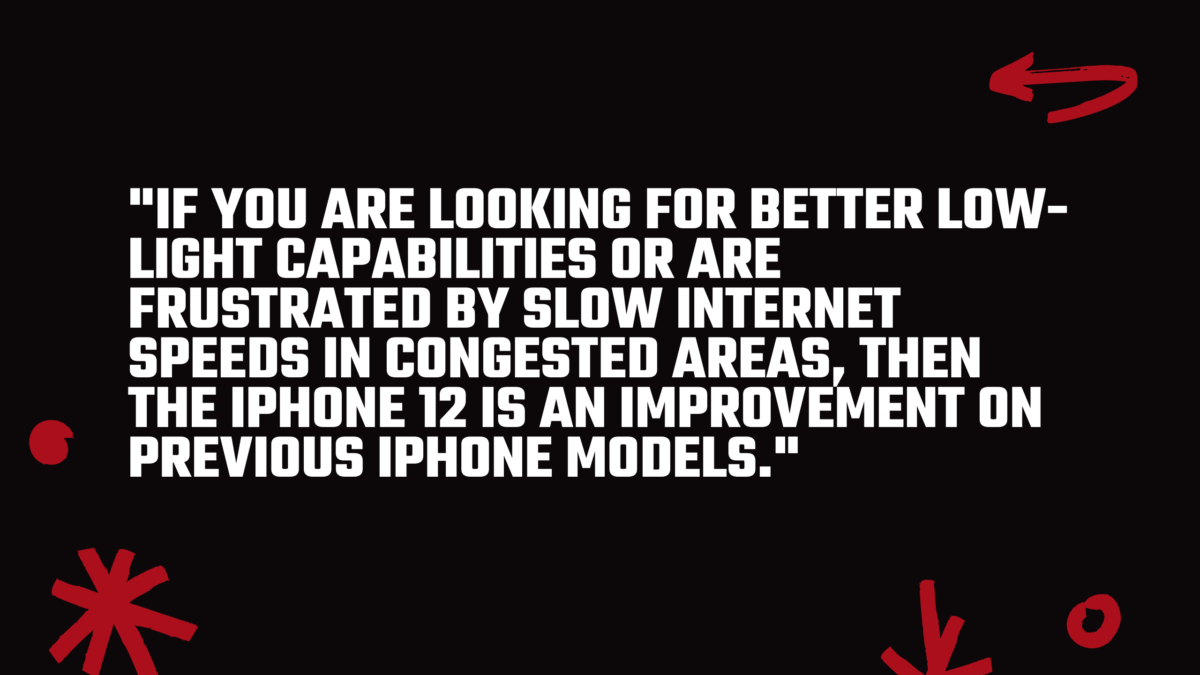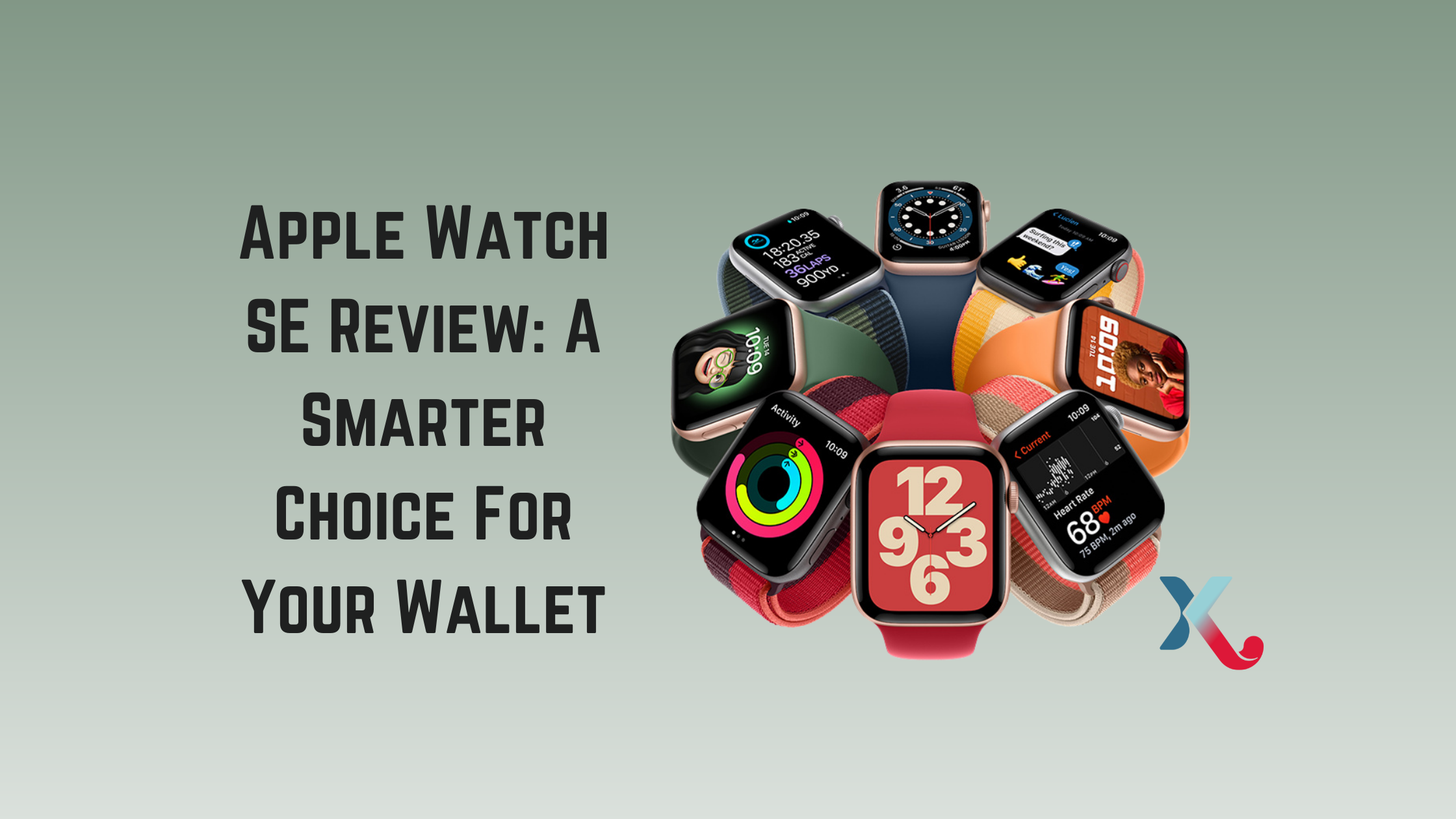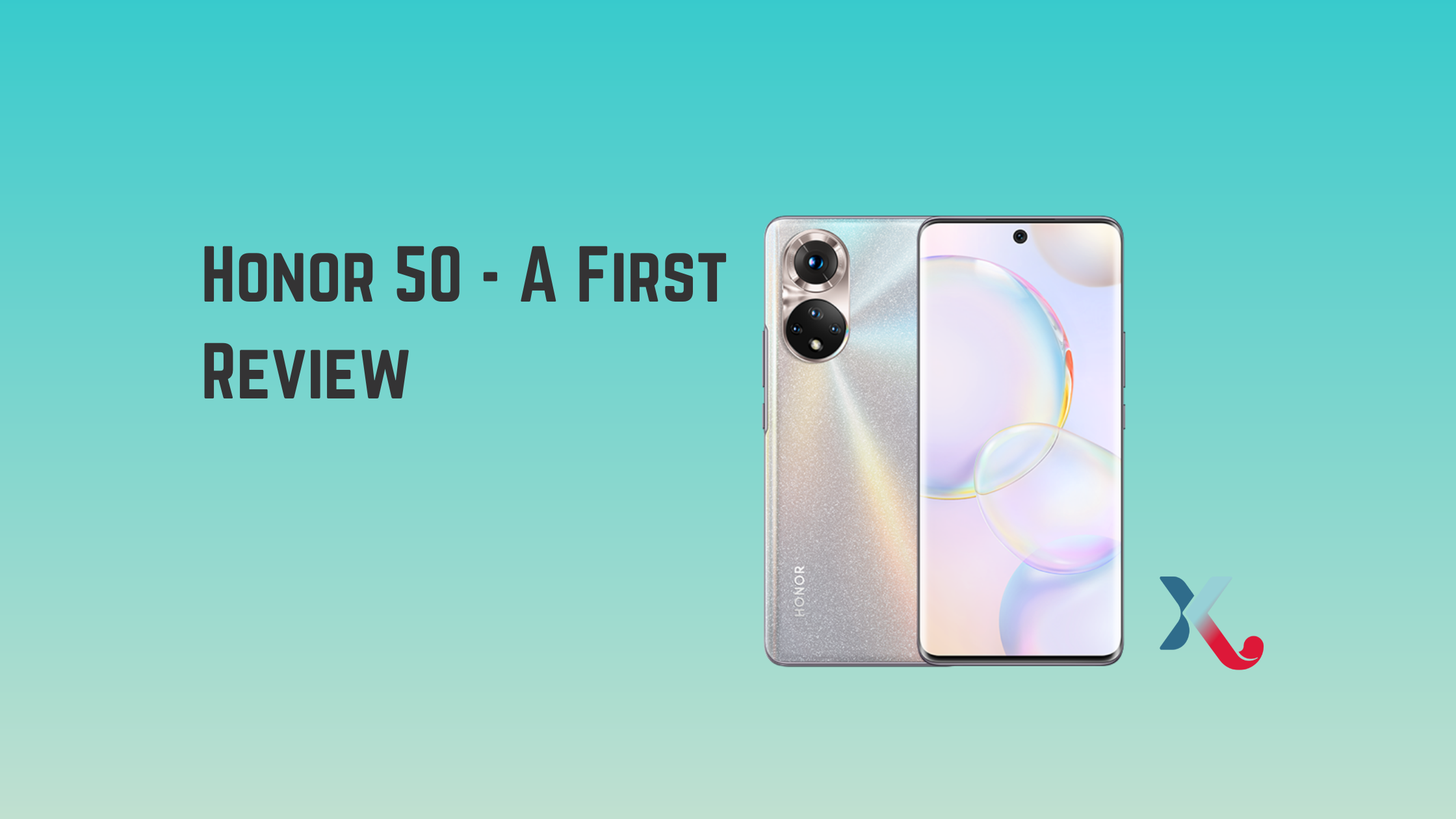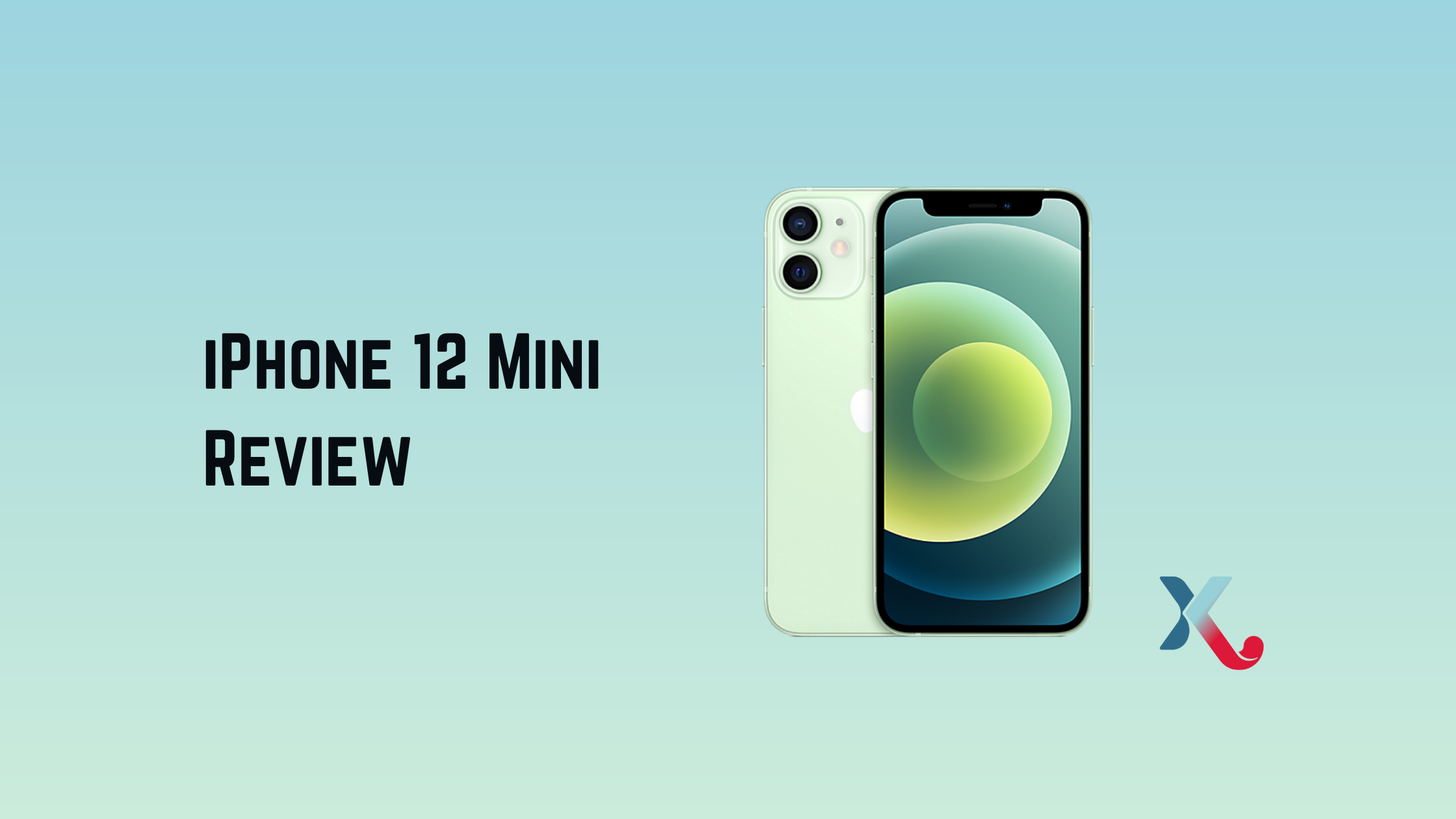The iPhone 12 series offers:
- top-notch design,
- great connectivity and
- an improved Night mode camera to the country’s most loved phone.
There are four models that look very similar, so which one is the best? It’s not easy…
PROS
- Excellent Night mode camera
- Better 4G (and 5G) than previous iPhones
- Beautiful build
- Solid battery life
CONS
- Several similar but not-quite-the-same models
- AT&T and Verizon 5G underwhelms
- Charging and power adapter situation is confusing
Apple’s iPhone 12 series offers a solid feel, great screens, improved low-light performance and better network connectivity. One of the four new iPhones will be worth your investment if you own an iPhone older than one year.
Apple spoke a lot about 5G during the launch, with good reason as the iPhone 12 seems to be the best 5G smartphone,
Re. networks – AT&T’s 5G “nationwide” and Verizon’s 5G are not worth your time.
T-Mobile’s 5G mid-band does offer better performance. However, T-Mobile doesn’t have a map, making it difficult to locate. The iPhone 12 series is a significant improvement in 4G performance, which I will detail shortly.
The iPhone 12 and 12 mini are identical, except for the screen size and battery size. If all things are equal, an iPhone slightly cheaper and smaller than the iPhone 6 or 8 is a winner.
The iPhone 12 Pro Max and Pro Max offer more advanced features for photo enthusiasts, including telephoto lenses and a Night Portrait mode, Dolby Vision processing, Raw photo handling, and better Dolby Vision handling. The extra money is worth it for photographers, but not for everyone. The Editors’ Choice Award for Camera Phones goes to the iPhone 12 Pro because it packs amazing images into a small phone. With its 6.7-inch display, the Pro Max is too big for most people.

It’s an Unlockable Phone
The iPhone 12 and 12 Mini are available in white, black, green, red, and red. The body has a matte metal border around its edges in a similar blue as the back. There are also some antenna windows made of black plastic and the usual buttons on the side. The camera module is a square-shaped piece that sticks out from the back of your phone. If you drop it, it will cause serious damage.
It’s difficult to distinguish the 12 Pro and the 12 Pro from the front. The 12 mini and Pro Max have different sizes. Both phones have the large notch at their tops that Apple uses for Face ID. They also have very small bezels surrounding their gorgeous screens. They are slightly smaller than iPhone 11 but significantly wider than iPhone 8 series, measuring 0.29 by 5.78 inches by 2.82 inches. The phones are small, which is surprising considering the current trend for flagship phones. However, those looking for a phone that feels more like an iPhone 6 or 7 should consider the 12 mini. The iPhone 12 Pro weighs in at 6.66 versus 5.78 ounces. Both are lighter than 11 but heavier than 8.
The glowing, saturated OLED screens have become the norm for high-end smartphones over the last few years. They are 5.4 inches in size and measure 2,340x 1,080 pixels for iPhone 12 mini, 6.1 inches for iPhone 12 and 12 Pro, and 2,532x 1,170 pixels, respectively for iPhone 12 and 12 Pro. The iPhone 12 Pro Max’s screen measures 6.7 inches and 2,778x 1,284 pixels. They are all more detailed and sharper than their iPhone 11 predecessors. The 12 and 12 Pro have about the same resolution as 11 Pro.
At 625 nits maximum brightness, the iPhone 12 and 12 mini’s screens appear slightly brighter than the iPhone 11. Pro Max and Pro Max have 800 nits each, but I didn’t notice any visual differences between them (and our screen-testing equipment is still in our COVID office). The panels all have 60Hz refresh rates, while the top Android phones have screens that are 90Hz or 120Hz. The frame rate difference can be seen when you film screens in slow motion. However, it is not noticeable in daily use as scrolling smoothness on iPhones has always been better than on Android phones. Apple’s 60Hz may be as fast as Android’s 90Hz.
Ceramic Shield is a Corning product that covers the screens. Apple claims it is four times less likely for it to break than older iPhone glass. PCMag doesn’t test for ruggedness.
Ceramic Shield does not seem to protect against scratches and scuffs. It’s more like a way station between you and your local screen repair shop than it is a guarantee that your screen will not need to be fixed.
Face ID is the new authentication method for iPhones. It was frustrating in 2020 as it can’t recognize the same face with or without a mask. The iPad Air this year has a fingerprint scanner at the power button. This is something I love and wish Apple used. These phones still have Lightning ports but no headphone socket.
iOS 14 runs almost identically on all iPhones except the iPhone X. The iPhone 8 may run a little slower.
Fast Running, Fast Charging
Apple phones don’t feel slow once they are launched. Future-proofing is more important than any other aspect of the processor speed. It prepares for applications that will be three to four years in the future. Apple generally ends support for new iOS versions after five or four years because of new CPUs. The iPhone 12 is faster than the iPhone 11, but I’d still choose it over the iPhone 11 for other reasons.
The 12 and 12 Pro have 2,815mAh batteries, smaller than the iPhone 11’s 3,110mAh battery, but these iPhones can last longer thanks to the OLED screens and the more efficient A14 processor. The battery of the 12 mini is smaller than that of the 12 Pro Max, while the 12 Pro Max has a larger one.
Apple didn’t include a power adapter with the box this year. The iPhones can charge at 20 watts. They can take that wattage at 9v and 2.22a. The old iPhone charger won’t charge the new iPhone at this speed, so you will probably need a new charger. The Anker Nano 20W ($19.99), a cute little charger, charged my iPhone 12 to 20% in ten minutes, 58% in thirty minutes, and 100% within 100 minutes.
The new iPhone can charge using your existing lightning cable and adapter. However, it will take a while. The older USB-A Lightning cables can only charge up to 12 W, while the older iPhone power adapters can only charge up to 5 W. New phones come with a Lightning to USB-C cable that can be used with up to 20W USB-C adapters. A USB-C adapter will be included if you own a new iPad or MacBook. If not, you may want to get the Anker Nano. Still confused? To help you, we have a complete charging explanation.
Apple’s MagSafe charger is a magnetic disk that can be inserted onto the backside of the phone. MagSafe claims to be capable of charging at 15W. It turns out that MagSafe charges up to 15W. The 20W Anker Nano charged at 11% and 52%, respectively, in 10 minutes. However, when I plugged in a 22W Samsung charger it gave me only 9% and took me 80 minutes to reach 50%.
Although the battery performance of the iPhone 12 was slightly different, they were all comparable to other flagship smartphones. The iPhone 12 was able to stream video on WiFi for 10 hours and 8 mins. The iPhone 12 Pro managed 12 hours and 34 mins.
More Than Just 5G
The iPhone 12 family uses Qualcomm X55 modems for all four members. This is the first all-Qualcomm iPhone line since the 6S. After years of inconsistent performance, I’m glad to report that iPhones have returned to the top of the Android phone market in terms of network performance.
The iPhone 12 series comes with a single SIM slot and software support to add a second line via an eSIM. It works well with voice quality, including the best EVS voice codec, WiFi calling and solid Bluetooth 5.0.
The iPhone 11 failed to pass a speed test in one area that was very weak, scoring 6 to 9Mbps, while the iPhone 12 Pro and 12 Pro did well. Although it isn’t as fast as the iPhone 11, it beats the 11’s inability to perform.
We have T-Mobile 5G mid-band on the iPhone 12 (left); TMobile 4G with 4×4 Multi-MIMO on the iPhone 12 Pro.
An area with stronger signals, but where 4G networks were congested, The iPhone 11 saw 1 to 3Mbps drop, while the iPhone 12 on LTE was able to run 44 to 48Mbps.
WiFi performance seems more consistent, too. The weak-signal Wi Fi test was conducted against a 500Mbps fibre connection. Both the iPhone 11 (and 12) reached 72Mbps while the 12 could hold it.
The iPhone series is also the first iPhones that support WiFi 6. It even offers a WiFi 6 connection if the phone’s in hotspot mode. WiFi 6 is important when we can go back to work and coffee shops because it reduces interference. It may also be helpful when the iPhone is used as a hotspot using a super-fast 5G millimetre wave connection.
These phones include Apple’s perplexing “ultrawideband” technology. Not to be confused with Verizon’s ultra-wideband 5G, which is completely different. Apple’s UWB wireless system has no real purpose. It is supposed to allow two devices to determine their positions relative to each other. Apple claims it can do file sharing to nearby devices and smart home items, but I have found it almost pointless since its debut last year.
Camera: Night Mode Begins to Shine
New iPhones come with sets of 12-megapixel cameras. Each iPhone 12 and 12 mini have 12-megapixel front-facing cameras and standard and wide-angle 12-megapixel cameras. The 12 Pro has a 12-megapixel 2x zoom, a LiDAR scanner and the 12 Pro Max has 2.5x zoom.
To determine distance, LiDAR uses light pulses to bounce off objects. It speeds up augmented reality applications and makes it easier to take photos.
Apple’s specs sheets will show that the iPhone 12 has “2x optical Zoom” and the 12 Pro has “4x optic zoom”. This is true only if you redefine how everyone in the smartphone world has used “zoom” over the past decade.
The ultrawide mode is not a default setting. A select few use it because it makes subjects too small. It is sensible to count the most used camera as 0.5x or 1x rather than pretending the main camera is some type of zoom and the ultrawide the default 1x camera.
Apple’s Night mode is a complete kill for most of its competitors. I compared the iPhone 12 Pro and the iPhone 11 to see which was better. You’d be hard-pressed to see a difference in top-of-the-line cameras outdoors, especially when there is good lighting. The photos below show that although the sky may be a different colour on each camera, the images are all beautiful.
Zoom in and you’ll see that the iPhone 12 Pro wins. It has a dedicated zoom lens. The 2x zoom of the 12 Pro gives you clarity that is impossible with the iPhone 12 or iPhone 11’s digital zoom, and oddly it even works better than the Galaxy Note 20. The Galaxy is the best. The Note 20 features a 5x optical zoom lens. At 5x, all iPhones blur, but the Note 20 is razor-sharp.
Night Mode is what makes the difference. The iPhone 12 series supports Night Mode on its front cameras, while the iPhone 11 does not. The 12 Pro Max and 12 Pro Max have LiDAR sensors that improve focus in low light. They also allow Night mode to capture bokeh portraits.
Night mode can make a big difference. The Samsung Galaxy S20’s Night Mode (left span> ) is as dim as the iPhone 12 Pro with night mode (right span>).
Night Portrait Mode is also available on the 12 Pro, which blurs out the background for night shots and makes for more dramatic pictures.
These cameras can achieve the Night mode’s amazing results with long exposures. However, they are not suited for moving subjects. My model was blurred when she started to skip. The same can be said for all cameras, but Apple phones are the best in video recording. However, there’s still a huge gap between pro-level and consumer-level usability that I would like to close. You can use the Pro Video mode on the Galaxy S20 Ultra to do useful things such as turn individual microphones off and change the aperture. You will need separate pro video apps on the iPhone to do this. These are more powerful but more complicated and jargon-laden user interfaces. R
Basic indoor Night Mode shots taken with the iPhone 11 or 12 series are identical.
The iPhone 12 has really great cameras. The 12 series will make your old phone look better in low light. The 12 Pro has additional capabilities, including a 2x zoom that is sharper and a Night Portrait mode that is truly dramatic.
The 12 Pro also offers various camera features that 95% of buyers will not be interested in. ProRAW is a new mode that allows pro-editors to have greater control over their edits. The Pro supports DolbyVision HDR video recording at 60fps. The iPhone 12 supports DolbyVision at 30fps. The Pro supports 4K video recording at 60fps, while the iPhone 12 supports Dolby Vision at 30fps. This is one of those obscure features that I find it hard to get excited about.
The Pro’s pro-level photography is worth the extra price. The iPhone 12’s Night mode and camera are excellent enough for most people. I’d argue that 4×4 MIMO antennas are worth the extra expense.
Despite this, I am confident that the iPhone is the best choice for professional photographers, YouTubers, and other visual artists.
Should you Upgrade to the iPhone 12?
The iPhone 12’s final verdict boils down to these two points: If you are looking for better low-light capabilities or are frustrated by slow Internet speeds in congested areas, then the iPhone 12 is an improvement on previous iPhone models.
It is remarkable to see the difference in low-light camera quality between the iPhone 12 compared to anything before the iPhone 11. The jump from 2×2 MIMO and 4×4 MIMO significantly improves connectivity performance in areas where signals are congested or blocked. 5G is available on T-Mobile. However, even if you are not on T-Mobile 5G will be a benefit.
The closest Android comparisons are the Samsung Galaxy S20 FE (or OnePlus 8T) and the OnePlus 8T. Both of these are excellent. Both are excellent. The iPhone 12’s low light camera is clearly superior to either of them. I also like the iPhone 12’s smaller body.
Where To Buy? At NIX Of Course!
Trade-in your old phones with NIX and leave with a brand new phone.
Remember, the NIX magic number is zero!! How close can you get? Come in and see.
Recycle your old phone with NIX and sign-up to our Premium Membership for even better prices and saving at NIX.
MEGA TIP: NIX Premium Members can trade in multiple devices at once to really reduce the price of the new phone.


